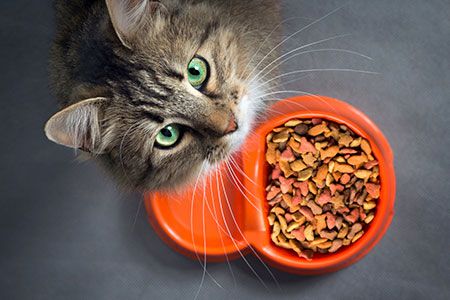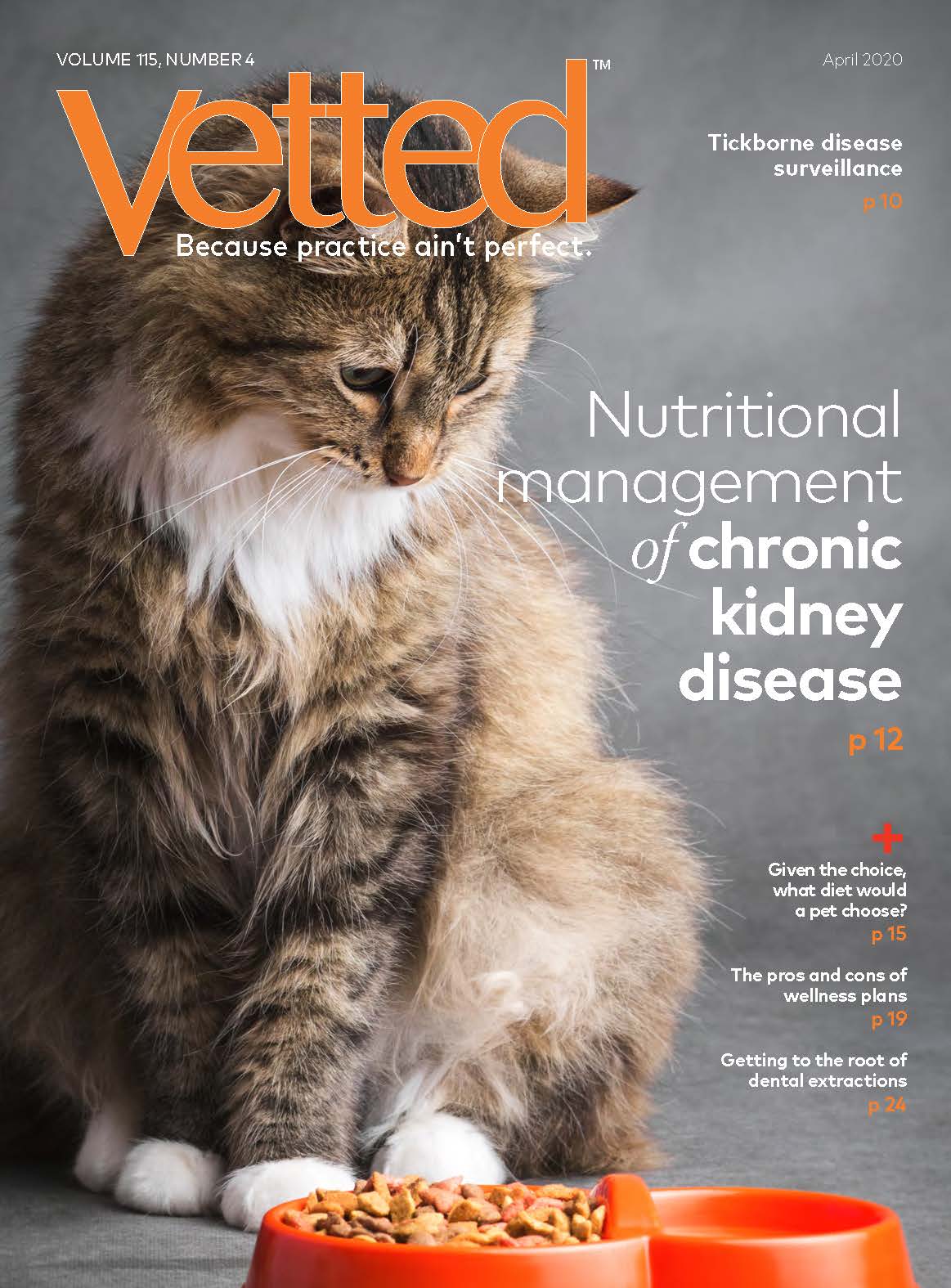Nutritional management of chronic kidney disease
Therapeutic diets are the gold standard in managing veterinary patients with CKD. Heres why, and how to coax these pets to eat.
fantom_rd/stock.adobe.com

Compared with maintenance diets, therapeutic renal diets generally have restricted protein, phosphorus and sodium levels. The quality of the protein in these diets is extremely important. Diets containing highly digestible protein with the correct balance of amino acids minimize nitrogenous waste. These calorically dense diets contain reduced amounts of dietary phosphorus, increased omega-3 fatty acids, antioxidants, B vitamins and potassium to help prevent hypokalemia, which has been shown to contribute to renal dysfunction. They also contain buffers to help control acidemia, which may contribute to muscle wasting. Protein sources of lesser quality generally contain nonessential amino acids that may be catabolized to urea and may contribute to increased clinical signs in patients with advanced stages of chronic kidney disease (CKD).
Therapeutic diets: the gold standard in CKD
Almost 20 years ago, results of a study by Elliott et al. showed that cats with CKD fed a therapeutic renal diet lived significantly longer than cats fed a maintenance diet (median survival time, 633 vs. 264 days).1 In another randomized double-blind study, cats fed a therapeutic renal diet experienced 26% fewer uremic episodes compared with those those fed a maintenance diet.2 None of the cats fed the renal diet died during the study, but 22% of those in the control group died.
In a presentation at the 2017 Hill's Global Symposium, Jessica Quimby, DVM, PhD, DACVIM, noted that “…based on published evidence, feeding a dietetic renal food is the single most effective management option for improving survival and quality of life in dogs and cats with CKD. While new emerging evidence highlights the benefits of dietetic renal food in dogs with IRIS [International Renal Interest Society] Stage 1 CKD, more research is needed to confirm the most optimal nutritional management in early stages of the disease.”3
Most renal diets fall within the Association of American Feed Control Officials' minimum requirements for adult maintenance diets for healthy dogs and cats. There is no evidence to support the premise that dogs and cats eating therapeutic renal diets will lose muscle weight or body weight if the patient is eating its daily caloric requirements of the diet. Results from a 2-year randomized controlled clinical trial showed no difference in body condition score or body weight in cats with CKD eating a renal diet versus a maintenance diet.4
Restricting dietary phosphorus has been shown to help slow the progression of renal disease. Several studies have shown that feeding therapeutic diets increases survival rates and significantly reduces plasma phosphorus and parathyroid hormone levels compared with feeding diets higher in phosphorus.5 As renal disease progresses, however, it may become impossible to keep phosphorus concentrations within the IRIS guidelines using diet alone. If serum phosphorus remains high 4 weeks after transitioning to a therapeutic renal diet, a phosphate binder should be considered.
High sodium levels in diets fed to patients with CKD may cause sodium retention due to the expansion of extracellular fluid volume, hypertension, fluid overload and edema. However, excessively limiting dietary sodium may cause a negative sodium balance resulting in reduced extracellular fluid volume, plasma volume and glomerular filtration rate (GFR). Dietary sodium has been shown to have no impact on blood pressure in dogs and cats. Restricting sodium may contribute to muscle wasting in cats.5
Cats with CKD are prone to potassium deficiency; however, this is not common in dogs. Decreased potassium levels may be caused by anoxia, vomiting and increased urinary losses due to polyuria. Serum potassium should be monitored and supplemented when necessary. For cats with hypokalemia, oral supplementation with potassium gluconate should be considered if diet alone does not maintain serum potassium concentration above 4.0 mEq/L.5 Oral administration is the safest and preferred method unless a critical emergency exists or oral administration is impossible or contraindicated. Oral potassium gluconate appears to be tolerated well by most patients. The dose is adjusted based on the patient's clinical signs and serum potassium levels, which initially should be checked every 2 to 4 days until stable and then every 2 to 4 weeks thereafter.
Getting the CKD patient to eat
The daily energy requirement (DER) for dogs with CKD is 1.1 to 1.6 times the patient's resting energy requirement (RER); for cats the DER is 1.1 to 1.4 times RER. A slow transition (dogs over 1-2 weeks or more, cats over 3-4 weeks or more) is recommended to increase the likelihood that the patient will accept the new diet and to enable a gradual change in urinary sodium levels.
Make the food enticing. Educating owners about the importance of feeding appropriate diets to these patients and the need to transition gradually is vital. Cats, in particular, can be resistant to diet changes. A number of tactics can be used to help the pet become accustomed to the new food:
- Transition to the new diet slowly.
- Offer the old and new diets in separate side-by-side dishes rather than combining them in a single dish.
- Offer the new diet in a flat dish rather than a bowl, even if the pet normally eats from a bowl.
- Add low-sodium tuna juice, chicken broth or even water to the food.
- Warm the food.
- Provide antiemetics for nauseated (or suspected nauseated) patients.
- Offer appetite stimulants, which may be especially effective when started at the hyporexia or dysrexia stage.
It is not unusual for the CKD patient to eat only a small amount of food or to stop eating altogether. In a 2015 survey of owners of cats with CKD, reduced appetite was reported by 43% of owners; 77% of those owners coaxed their cat to eat 50% of the time.6
Patients with CKD that do not consume their daily caloric requirement will suffer muscle loss as it is catabolized to provide energy to the body. Reduced food intake also means the patient is not consuming adequate protein, which will also lead to muscle loss.
Suggest an E-tube. An often underutilized option is the use of an esophageal feeding tube. Not only can E-tube feeding extend a patient's life, it can help improve quality of life for both the patient and the owner. Veterinary therapeutic diets may be made into a slurry, and most clients can manage assisted feeding easily at home. Clients can also administer the multiple medications that many CKD patients have been prescribed via the feeding tube, often more easily than by mouth. Additional water administered via the feeding tube can eliminate the need for subcutaneous fluids; not only is this easier for most clients but the water is used more easily by the body.
References
1. Elliott J, Rawlings JM, Markwell PJ, Barber PJ. Survival of cats with naturally occurring chronic renal failure: effect of dietary management. J Small Anim Pract 2000;41(6):235-242.
2. Ross SJ, Osborne CA, Kirk CA, et al. Clinical evaluation of dietary modification for treatment of spontaneous chronic kidney disease in cats. J Am Vet Med Assoc 2006;229(6):949-957.
3. Quimby J, Becvarova I: Protein requirements for cats and dogs with early chronic kidney disease-Is there an answer. Presented at the 2017 Hill's Global Symposium. May 5-6, 2017. Washington, DC. http://hillsglobalsymposium.com/library/download_notes/L19-Quimby%20Becvarova%20-%20Protein%20Requirements%20in%20Dogs%20and%20Cats%20in%20Stage%201%20CKD.pdf
4. Ross SJ, Osborne CA, Kirk CA, Lowry SR. Clinical evaluation of dietary modification for treatment of spontaneous chronic kidney disease in cats. J Am Vet Med Assoc 2006;229:949-957.
5. Hand MA, Thatcher CD, Remillard RL, et al (Eds): Small Animal Clinical Nutrition, 5th ed. Topeka, KS: The Mark Morris Institute; 2010:785-791.
6. Markovich JE, Freeman LM, Labato MA, Heinze CR. Survey of dietary and medication practices of owners of cats with chronic kidney disease. J Feline Med Surg 2015;17(12):979-983.
Ed Carlson, CVT, VTS (nutrition), is the technician learning and development manager at InTown Veterinary Group.

Episode 67: Choosing trusted supplements
October 20th 2021In this episode of The Vet Blast Podcast, Dr Adam Christman chats with Dr Janice Huntingford about the latest insights into selecting the best supplements for your patients, including the importance of recommending and utilizing products that have a substantial amount of science and research behind them. (Sponsored by Vetoquinol)
Listen